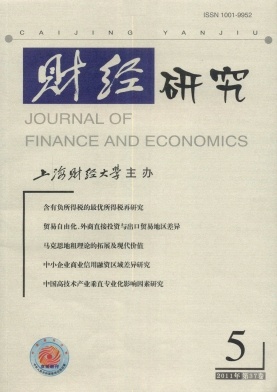垄断性资源定价、竞合博弈与序贯决策——以铁矿为例
财经研究 2011 年 第 37 卷第 05 期, 页码:102 - 112
摘要
参考文献
摘要
文章依据铁矿石价格谈判的背景和原则,构建了供应链上游资源垄断者和下游两生产企业之间竞争及竞合的两个博弈定价模型。研究表明,供应链上游资源垄断者主要依据下游生产企业的利润水平确定其资源定价,影响下游议价能力的根本因素是其产量而非谈判技巧,竞合策略下价格谈判的先行者将获得更大的产量和利润优势。算例仿真结果则显示,与竞争策略相比,合作谈判策略能有效提高供应链下游生产企业的议价能力,降低上游垄断者的资源定价能力,有效缩减整体谈判成本。
[1]白让让.买方主垄断:政府规制与电煤价格的长期扭曲[J].世界经济,2009,(8):83-96.
[2]卢周来.合作博弈框架下企业内部权力的分配[J].经济研究,2009,44(12):106-118.
[3]郑锦荣,徐福缘,陈滨桐.铁矿砂谈判中谈判定价权争夺的博弈研究[J].管理世界,2010,(3):108-116.
[4]Aspremont C,Jacquemin A.Cooperative and noncooperative R&D in duopoly withspillovers[J].American Economic Review,1988,78(5):1133-1137.
[5]Bernhei m D,Whinston M.Common marketing agency as a device for facilitating collu-sion[J].Rand Journal of Economics,1985,16(2):269-281.
[6]Boyer M,Moreaux M.Rational rationing in Stackelberg equilibria[J].Quarterly Jour-nal of Economics,1988,103(2):409-414.
[7]Henriques I.Cooperative and noncooperative R&Din duopoly with spillovers:Com-ment[J].American Economic Review,1990,80(3):638-640.
[8]Hol mstrom B,Milgrom P.Aggregation and linearity in the provision of intertemporalincentives[J].Econometrica,1987,55(2):303-328.
[9]Kamien MI,Muller E,Zang I.Researchjoint ventures and R&Dcartels[J].AmericanEconomic Review,1992,82(5):1293-1306.
[10]Laffont J.Theoretical incentive theory[M].Beijing:Peking University Press,2001.
[11]Meyer M A,Vickers J.Performance comparisons and dynamic incentives[J].Journalof Political Economy,1997,105(3):547-581.
[12]Nalebuff B,Brandenburger M.Co-opetition[M].London:Emerald Press,1996.
[13]Stackelberg H.Marktformund gleichgewicht[M].Vienna:Springer Press,1934.
[14]Xie J,Wei J C.Coordinating advertising and pricingin a manufacturer-retailer chan-nel[J].European Journal of Operational Research,2009,197(2):785-791.
[2]卢周来.合作博弈框架下企业内部权力的分配[J].经济研究,2009,44(12):106-118.
[3]郑锦荣,徐福缘,陈滨桐.铁矿砂谈判中谈判定价权争夺的博弈研究[J].管理世界,2010,(3):108-116.
[4]Aspremont C,Jacquemin A.Cooperative and noncooperative R&D in duopoly withspillovers[J].American Economic Review,1988,78(5):1133-1137.
[5]Bernhei m D,Whinston M.Common marketing agency as a device for facilitating collu-sion[J].Rand Journal of Economics,1985,16(2):269-281.
[6]Boyer M,Moreaux M.Rational rationing in Stackelberg equilibria[J].Quarterly Jour-nal of Economics,1988,103(2):409-414.
[7]Henriques I.Cooperative and noncooperative R&Din duopoly with spillovers:Com-ment[J].American Economic Review,1990,80(3):638-640.
[8]Hol mstrom B,Milgrom P.Aggregation and linearity in the provision of intertemporalincentives[J].Econometrica,1987,55(2):303-328.
[9]Kamien MI,Muller E,Zang I.Researchjoint ventures and R&Dcartels[J].AmericanEconomic Review,1992,82(5):1293-1306.
[10]Laffont J.Theoretical incentive theory[M].Beijing:Peking University Press,2001.
[11]Meyer M A,Vickers J.Performance comparisons and dynamic incentives[J].Journalof Political Economy,1997,105(3):547-581.
[12]Nalebuff B,Brandenburger M.Co-opetition[M].London:Emerald Press,1996.
[13]Stackelberg H.Marktformund gleichgewicht[M].Vienna:Springer Press,1934.
[14]Xie J,Wei J C.Coordinating advertising and pricingin a manufacturer-retailer chan-nel[J].European Journal of Operational Research,2009,197(2):785-791.
引用本文
王洁. 垄断性资源定价、竞合博弈与序贯决策——以铁矿为例[J]. 财经研究, 2011, 37(5): 102–112.
导出参考文献,格式为:





 7264
7264  4539
4539

